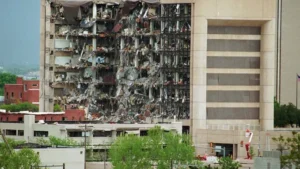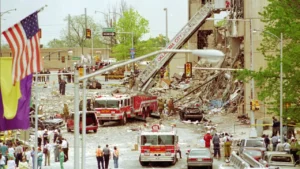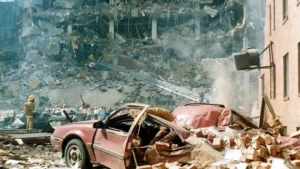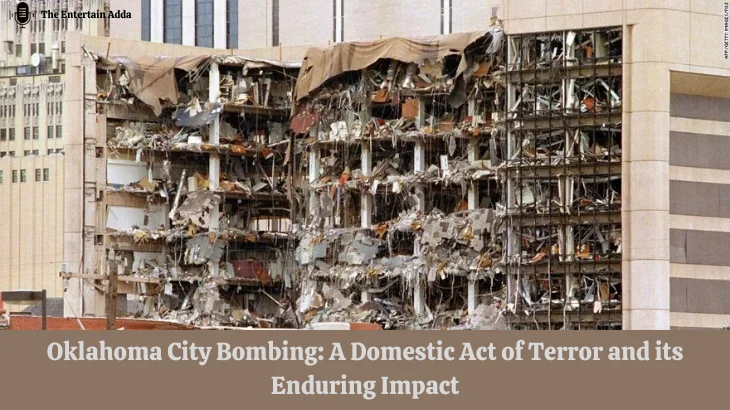The Oklahoma City Bombing: The Alfred P. Murrah Federal Building in Oklahoma City stood as a symbol of authority on a peaceful Wednesday morning in April 1995. However, at precisely 9:02 am, that symbol was crushed by a booming explosion that echoed across the nation.
 A massive truck bomb exploded tearing through the building and leaving behind a scene of devastation. This act of domestic terrorism, orchestrated by Timothy McVeigh, remains the deadliest in U.S. history prior to the September 11th attacks, forever etching itself into the nation’s memory.
A massive truck bomb exploded tearing through the building and leaving behind a scene of devastation. This act of domestic terrorism, orchestrated by Timothy McVeigh, remains the deadliest in U.S. history prior to the September 11th attacks, forever etching itself into the nation’s memory.
Motives Fueled by Anti-Government Rage
McVeigh, a former Army soldier, was deeply disappointed with the federal government. The deadly 1993 siege of Waco, Texas where federal agents clashed with a religious sect resulting in the loss of 76 lives, fueled his anti-government rage.
McVeigh saw the incident as an example of government overreach and tyranny. The Oklahoma City bombing carried out on the second anniversary of the Waco siege, was a calculated act of revenge against the very institution he loathed.
A Devastating Impact: Loss of Life and a City Scarred
The bomb, which was made from a dangerous mix of fuel oil and fertilizer, caused unimaginable damage. The north face of the Murrah Building fell, burying federal workers, creche workers, and people who were just watching in a pile of concrete and other rubble.
The final number of deaths was 168 with 19 children among them. Hundreds more were injured and some will have permanent mental and physical scars. Aside from the deaths, the blast left Oklahoma City with a huge wound. The city area that used to be busy turned into a scene of broken glass and twisted metal.
The damage to more than 300 buildings impacted local companies. After the event, people in the city were filled with fear, sadness, and anger.
A Swift Investigation and the Pursuit of Justice
Right after the Oklahoma City Bombing, there was an instant and huge response. Rescue efforts started right away, with first responders and regular people working hard to pull survivors from the wreckage.
The FBI began a full investigation and within a day released a sketch of a suspect. A police officer caught Timothy McVeigh during a normal traffic stop not long after the blast. The investigation also found that Terry Nichols and Michael Fortier were part of McVeigh’s plan.
 The authorities confirmed all of McVeigh’s charges to be true, and they spared him from death. Someone killed him in 2001. Fortier’s sentence was lighter because he helped the cops, but Nichols’s was life in prison without the chance of parole.
The authorities confirmed all of McVeigh’s charges to be true, and they spared him from death. Someone killed him in 2001. Fortier’s sentence was lighter because he helped the cops, but Nichols’s was life in prison without the chance of parole.
The Oklahoma City Bombing: A Catalyst for Change
The bombing made the country face the growing danger of terrorism in its own country. It led the federal government to step up its efforts to keep an eye on radical groups and make it easier for law enforcement agencies to talk to each other.
The bombing also prompted Congress to pass the Antiterrorism and Effective Death Penalty Act of 1996. This law gave the government more power to look into terrorist threats.
Oklahoma City Remembers: A City Healed but Not Forgotten
The place where the bombing happened is now the Oklahoma City National Memorial & Museum, a moving place to remember the dead and honor them. The chairs set up in the plaza outside stand for the victims. Each empty seat starkly reminds us of the lives lost.
The museum tells the story of all that happened before the bombing, the scary efforts to save people, and how the city got better afterward. Oklahoma City has come a long way since the bombing but people still remember it.
 April 19, is still a day of remembering. Survivors and families of victims gather to honor their loved ones.
April 19, is still a day of remembering. Survivors and families of victims gather to honor their loved ones.
Conclusion
The terrible act of domestic terrorism known as the Oklahoma City Bombing will always be remembered in American history. It killed innocent people, and destroyed a city but from the ashes of sadness came a story of strength and a city that would not let its worst moment define it.
The bombing is a stark warning of the significance of vigilance against those who seek to sow violence and division.
FAQ’s
Q. Who was Timothy McVeigh?
A. McVeigh was a former US soldier who harbored anti-government views.
Q. What was the motive for the Bombing?
A. McVeigh carried out the blast as a way to get back at the federal government. He went after the Murrah Building as it was home to government agencies.
{
“@context”: “https://schema.org”,
“@type”: “FAQPage”,
“mainEntity”: [{
“@type”: “Question”,
“name”: “Who was Timothy McVeigh?”,
“acceptedAnswer”: {
“@type”: “Answer”,
“text”: “McVeigh was a former US soldier who harbored anti-government views.”
}
},{
“@type”: “Question”,
“name”: “What was the motive for the Bombing?”,
“acceptedAnswer”: {
“@type”: “Answer”,
“text”: “McVeigh carried out the blast as a way to get back at the federal government. He went after the Murrah Building as it was home to government agencies.”
}
}]
}

